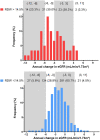Red Blood Cell Distribution Width Is Associated With Adverse Kidney Outcomes in Patients With Chronic Kidney Disease
- PMID: 35755057
- PMCID: PMC9218182
- DOI: 10.3389/fmed.2022.877220
Red Blood Cell Distribution Width Is Associated With Adverse Kidney Outcomes in Patients With Chronic Kidney Disease
Abstract
Background: Chronic kidney disease (CKD) is a global public health issue. Red blood cell distribution width (RDW) is a recently recognized potential inflammatory marker, which mirrors the variability in erythrocyte volume. Studies indicate that elevated RDW is associated with increased risk of mortality in CKD patients, while evidence regarding the impact of RDW on kidney outcome is limited.
Methods: Altogether 523 patients with CKD stage 1-4 from a single center were enrolled. We identified the cutoff point for RDW level using maximally selected log-rank statistics. The time-averaged estimated glomerular filtration rate (eGFR) slope was determined using linear mixed effects models. Rapid CKD progression was defined by an eGFR decline >5 ml/min/1.73 m2/year. The composite endpoints were defined as doubling of serum creatinine, a 30% decline in initial eGFR or incidence of eGFR < 15 ml/min/1.73 m2, whichever occurred first. Multivariable logistic regression or Cox proportional hazards regression was performed, as appropriate.
Results: During a median follow-up of 26 [interquartile range (IQR): 12, 36] months, 65 (12.43%) patients suffered a rapid CKD progression and 172 (32.89%) composite kidney events occurred at a rate of 32.3/100 patient-years in the high RDW group, compared with 14.7/100 patient-years of the remainder. The annual eGFR change was clearly steeper in high RDW group {-3.48 [95% confidence interval (CI): -4.84, -2.12] ml/min/1.73 m2/year vs. -1.86 [95% CI: -2.27, -1.45] ml/min/1.73 m2/year among those with RDW of >14.5% and ≤14.5%, respectively, P for between-group difference <0.05}. So was the risk of rapid renal function loss (odds ratio = 6.79, 95% CI: 3.08-14.97) and composite kidney outcomes (hazards ratio = 1.51, 95% CI: 1.02-2.23). The significant association remained consistent in the sensitivity analysis.
Conclusion: Increased RDW value is independently associated with accelerated CKD deterioration. Findings of this study suggest RDW be a potential indicator for risk of CKD progression.
Keywords: chronic kidney disease (CKD); estimated glomerular filtration rate (eGFR) slope; kidney outcomes; rapid CKD progression; red blood cell distribution width.
Copyright © 2022 Deng, Gao, Wang, Zhao, Wang and Zhang.
Conflict of interest statement
The authors declare that the research was conducted in the absence of any commercial or financial relationships that could be construed as a potential conflict of interest.
Figures




Similar articles
-
The Prognostic Role of RDW in Hospitalized Heart Failure Patients with and Without Chronic Kidney Disease.J Clin Med. 2024 Dec 4;13(23):7395. doi: 10.3390/jcm13237395. J Clin Med. 2024. PMID: 39685852 Free PMC article.
-
Red cell distribution width and renal outcome in patients with non-dialysis-dependent chronic kidney disease.PLoS One. 2018 Jun 11;13(6):e0198825. doi: 10.1371/journal.pone.0198825. eCollection 2018. PLoS One. 2018. PMID: 29889895 Free PMC article.
-
Red blood cell distribution width is a predictor of chronic kidney disease progression and all-cause mortality.Bratisl Lek Listy. 2021;122(1):49-55. doi: 10.4149/BLL_2021_006. Bratisl Lek Listy. 2021. PMID: 33393321
-
Potential Role and Limitations of Estimated Glomerular Filtration Rate Slope Assessment in Cardiovascular Trials: A Review.JAMA Cardiol. 2022 May 1;7(5):549-555. doi: 10.1001/jamacardio.2021.5151. JAMA Cardiol. 2022. PMID: 34985495 Review.
-
Arterial Stiffness and Decline in Kidney Function.Clin J Am Soc Nephrol. 2015 Dec 7;10(12):2190-7. doi: 10.2215/CJN.03000315. Epub 2015 Nov 12. Clin J Am Soc Nephrol. 2015. PMID: 26563380 Free PMC article. Review.
Cited by
-
The Prognostic Role of RDW in Hospitalized Heart Failure Patients with and Without Chronic Kidney Disease.J Clin Med. 2024 Dec 4;13(23):7395. doi: 10.3390/jcm13237395. J Clin Med. 2024. PMID: 39685852 Free PMC article.
-
Red cell distribution width and its polygenic score in relation to mortality and cardiometabolic outcomes.Front Cardiovasc Med. 2023 Nov 20;10:1294218. doi: 10.3389/fcvm.2023.1294218. eCollection 2023. Front Cardiovasc Med. 2023. PMID: 38054099 Free PMC article.
-
Correlation of Albumin, Red Cell Distribution Width and Other Biochemical and Hematological Parameters with Glycated Hemoglobin in Diabetic, Prediabetic and Non-Diabetic Patients.Int J Mol Sci. 2024 Jul 23;25(15):8037. doi: 10.3390/ijms25158037. Int J Mol Sci. 2024. PMID: 39125606 Free PMC article.
-
Utilizing red blood cell distribution width (RDW) as a reliable biomarker to predict treatment effects after chimeric antigen receptor T cell therapy.Clin Exp Med. 2024 May 21;24(1):105. doi: 10.1007/s10238-024-01373-5. Clin Exp Med. 2024. PMID: 38771501 Free PMC article.
-
Are the Hematological Parameters Useful in Differentiating Acute Pyelonephritis from Cystitis in Patients with Chronic Kidney Disease?Maedica (Bucur). 2024 Sep;19(3):511-518. doi: 10.26574/maedica.2024.19.3.511. Maedica (Bucur). 2024. PMID: 39553351 Free PMC article.
References
-
- Kalantar-Zadeh K, Jafar TH, Nitsch D, Neuen BL, Perkovic V. Chronic kidney disease. Lancet. (2021) 398:786–802. - PubMed
LinkOut - more resources
Full Text Sources
Medical
Research Materials
Miscellaneous

